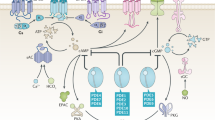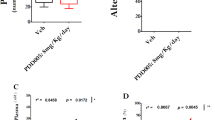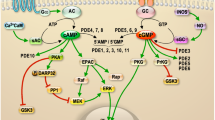Abstract
Phosphodiesterase 4 (PDE4), the primary cAMP-hydrolyzing enzyme in cells, is a promising drug target for a wide range of conditions. Here we present seven co-crystal structures of PDE4 and bound inhibitors that show the regulatory domain closed across the active site, thereby revealing the structural basis of PDE4 regulation. This structural insight, together with supporting mutagenesis and kinetic studies, allowed us to design small-molecule allosteric modulators of PDE4D that do not completely inhibit enzymatic activity (Imax ∼ 80–90%). These allosteric modulators have reduced potential to cause emesis, a dose-limiting side effect of existing active site–directed PDE4 inhibitors, while maintaining biological activity in cellular and in vivo models. Our results may facilitate the design of CNS therapeutics modulating cAMP signaling for the treatment of Alzheimer's disease, Huntington's disease, schizophrenia and depression, where brain distribution is desired for therapeutic benefit.
This is a preview of subscription content, access via your institution
Access options
Subscribe to this journal
Receive 12 print issues and online access
$209.00 per year
only $17.42 per issue
Buy this article
- Purchase on Springer Link
- Instant access to full article PDF
Prices may be subject to local taxes which are calculated during checkout







Similar content being viewed by others
References
Omori, K. & Kotera, J. Overview of PDEs and their regulation. Circ. Res. 100, 309–327 (2007).
Wang, H., Robinson, H. & Ke, H. The molecular basis for different recognition of substrates by phosphodiesterase families 4 and 10. J. Mol. Biol. 371, 302–307 (2007).
Bolger, G. et al. A family of human phosphodiesterases homologous to the dunce learning and memory gene product of Drosophila melanogaster are potential targets for antidepressant drugs. Mol. Cell. Biol. 13, 6558–6571 (1993).
Jacobitz, S., McLaughlin, M.M., Livi, G.P., Burman, M. & Torphy, T.J. Mapping the functional domains of human recombinant phosphodiesterase 4A: structural requirements for catalytic activity and rolipram binding. Mol. Pharmacol. 50, 891–899 (1996).
Rocque, W.J. et al. Human recombinant phosphodiesterase 4B2B binds (R)-rolipram at a single site with two affinities. Biochemistry 36, 14250–14261 (1997).
Beard, M.B. et al. UCR1 and UCR2 domains unique to the cAMP-specific phosphodiesterase family form a discrete module via electrostatic interactions. J. Biol. Chem. 275, 10349–10358 (2000).
MacKenzie, S.J. et al. Long PDE4 cAMP specific phosphodiesterases are activated by protein kinase A-mediated phosphorylation of a single serine residue in Upstream Conserved Region 1 (UCR1). Br. J. Pharmacol. 136, 421–433 (2002).
Sette, C. & Conti, M. Phosphorylation and activation of a cAMP-specific phosphodiesterase by the cAMP-dependent protein kinase. Involvement of serine 54 in the enzyme activation. J. Biol. Chem. 271, 16526–16534 (1996).
Shakur, Y., Pryde, J.G. & Houslay, M.D. Engineered deletion of the unique N-terminal domain of the cyclic AMP-specific phosphodiesterase RD1 prevents plasma membrane association and the attainment of enhanced thermostability without altering its sensitivity to inhibition by rolipram. Biochem. J. 292, 677–686 (1993).
Bolger, G.B. et al. The unique amino-terminal region of the PDE4D5 cAMP phosphodiesterase isoform confers preferential interaction with beta-arrestins. J. Biol. Chem. 278, 49230–49238 (2003).
Bolger, G.B. et al. Scanning peptide array analyses identify overlapping binding sites for the signalling scaffold proteins, beta-arrestin and RACK1, in cAMP-specific phosphodiesterase PDE4D5. Biochem. J. 398, 23–36 (2006).
Lehnart, S.E. et al. Phosphodiesterase 4D deficiency in the ryanodine-receptor complex promotes heart failure and arrhythmias. Cell 123, 25–35 (2005).
Blokland, A., Schreiber, R. & Prickaerts, J. Improving memory: a role for phosphodiesterases. Curr. Pharm. Des. 12, 2511–2523 (2006).
Houslay, M.D., Schafer, P. & Zhang, K.Y. Keynote review: phosphodiesterase-4 as a therapeutic target. Drug Discov. Today 10, 1503–1519 (2005).
DeMarch, Z., Giampa, C., Patassini, S., Bernardi, G. & Fusco, F.R. Beneficial effects of rolipram in the R6/2 mouse model of Huntington's disease. Neurobiol. Dis. 30, 375–387 (2008).
Zhang, H.T. Cyclic AMP-specific phosphodiesterase-4 as a target for the development of antidepressant drugs. Curr. Pharm. Des. 15, 1688–1698 (2009).
Giembycz, M.A. Life after PDE4: overcoming adverse events with dual-specificity phosphodiesterase inhibitors. Curr. Opin. Pharmacol. 5, 238–244 (2005).
Spina, D. PDE4 inhibitors: current status. Br. J. Pharmacol. 155, 308–315 (2008).
Robichaud, A. et al. Deletion of phosphodiesterase 4D in mice shortens alpha(2)-adrenoceptor-mediated anesthesia, a behavioral correlate of emesis. J. Clin. Invest. 110, 1045–1052 (2002).
Robichaud, A., Savoie, C., Stamatiou, P.B., Tattersall, F.D. & Chan, C.C. PDE4 inhibitors induce emesis in ferrets via a noradrenergic pathway. Neuropharmacology 40, 262–269 (2001).
Aoki, M. et al. Studies on mechanisms of low emetogenicity of YM976, a novel phosphodiesterase type 4 inhibitor. J. Pharmacol. Exp. Ther. 298, 1142–1149 (2001).
Giembycz, M.A. Development status of second generation PDE4 inhibitors for asthma and COPD: the story so far. Monaldi Arch. Chest Dis. 57, 48–64 (2002).
Conn, P.J., Christopoulos, A. & Lindsley, C.W. Allosteric modulators of GPCRs: a novel approach for the treatment of CNS disorders. Nat. Rev. Drug Discov. 8, 41–54 (2009).
Altucci, L., Leibowitz, M.D., Ogilvie, K.M., de Lera, A.R. & Gronemeyer, H. RAR and RXR modulation in cancer and metabolic disease. Nat. Rev. Drug Discov. 6, 793–810 (2007).
Hoffmann, R., Wilkinson, I.R., McCallum, J.F., Engels, P. & Houslay, M.D. cAMP-specific phosphodiesterase HSPDE4D3 mutants which mimic activation and changes in rolipram inhibition triggered by protein kinase A phosphorylation of Ser-54: generation of a molecular model. Biochem. J. 333, 139–149 (1998).
Houslay, M.D. & Adams, D.R. PDE4 cAMP phosphodiesterases: modular enzymes that orchestrate signalling cross-talk, desensitization and compartmentalization. Biochem. J. 370, 1–18 (2003).
Saldou, N. et al. Comparison of recombinant human PDE4 isoforms: interaction with substrate and inhibitors. Cell. Signal. 10, 427–440 (1998).
Souness, J.E. & Rao, S. Proposal for pharmacologically distinct conformers of PDE4 cyclic AMP phosphodiesterases. Cell. Signal. 9, 227–236 (1997).
Brideau, C., Van Staden, C., Styhler, A., Rodger, I.W. & Chan, C.C. The effects of phosphodiesterase type 4 inhibitors on tumour necrosis factor-alpha and leukotriene B4 in a novel human whole blood assay. Br. J. Pharmacol. 126, 979–988 (1999).
Reid, P. Roflumilast Altana Pharma. Curr. Opin. Investig. Drugs 3, 1165–1170 (2002).
Lorimer, D. et al. Gene Composer: database software for protein construct design, codon engineering, and gene synthesis. BMC Biotechnol. 9, 36 (2009).
Raymond, A. et al. Combined protein construct and synthetic gene engineering for heterologous protein expression and crystallization using Gene Composer. BMC Biotechnol. 9, 37 (2009).
Lim, J., Pahlke, G. & Conti, M. Activation of the cAMP-specific phosphodiesterase PDE4D3 by phosphorylation. Identification and function of an inhibitory domain. J. Biol. Chem. 274, 19677–19685 (1999).
Wang, P. et al. Expression, purification, and characterization of human cAMP-specific phosphodiesterase (PDE4) subtypes A, B, C, and D. Biochem. Biophys. Res. Commun. 234, 320–324 (1997).
Xu, R.X. et al. Crystal structures of the catalytic domain of phosphodiesterase 4B complexed with AMP, 8-Br-AMP, and rolipram. J. Mol. Biol. 337, 355–365 (2004).
Robichaud, A., Tattersall, F.D., Choudhury, I. & Rodger, I.W. Emesis induced by inhibitors of type IV cyclic nucleotide phosphodiesterase (PDE IV) in the ferret. Neuropharmacology 38, 289–297 (1999).
Card, G.L. et al. Structural basis for the activity of drugs that inhibit phosphodiesterases. Structure 12, 2233–2247 (2004).
McCahill, A. et al. In resting COS1 cells a dominant negative approach shows that specific, anchored PDE4 cAMP phosphodiesterase isoforms gate the activation, by basal cyclic AMP production, of AKAP-tethered protein kinase A type II located in the centrosomal region. Cell. Signal. 17, 1158–1173 (2005).
Chambers, R.J. et al. A new chemical tool for exploring the role of the PDE4D isozyme in leukocyte function. Bioorg. Med. Chem. Lett. 16, 718–721 (2006).
Souness, J.E. et al. Suppression of eosinophil function by RP 73401, a potent and selective inhibitor of cyclic AMP-specific phosphodiesterase: comparison with rolipram. Br. J. Pharmacol. 115, 39–46 (1995).
Mihara, T. et al. Pharmacological characterization of a novel, potent adenosine A1 and A2A receptor dual antagonist, 5-[5-amino-3-(4-fluorophenyl)pyrazin-2-yl]-1-isopropylpyridine-2(1H)-one (ASP5854), in models of Parkinson's disease and cognition. J. Pharmacol. Exp. Ther. 323, 708–719 (2007).
Bailey, C.H., Bartsch, D. & Kandel, E.R. Toward a molecular definition of long-term memory storage. Proc. Natl. Acad. Sci. USA 93, 13445–13452 (1996).
Robichaud, A. et al. Assessing the emetic potential of PDE4 inhibitors in rats. Br. J. Pharmacol. 135, 113–118 (2002).
Hirose, R. et al. Correlation between emetic effect of phosphodiesterase 4 inhibitors and their occupation of the high-affinity rolipram binding site in Suncus murinus brain. Eur. J. Pharmacol. 573, 93–99 (2007).
Ueno, S., Matsuki, N. & Saito, H. Suncus murinus: a new experimental model in emesis research. Life Sci. 41, 513–518 (1987).
MacKenzie, S.J., Baillie, G.S., McPhee, I., Bolger, G.B. & Houslay, M.D. ERK2 mitogen-activated protein kinase binding, phosphorylation, and regulation of the PDE4D cAMP-specific phosphodiesterases. The involvement of COOH-terminal docking sites and NH2-terminal UCR regions. J. Biol. Chem. 275, 16609–16617 (2000).
Millar, J.K. et al. DISC1 and PDE4B are interacting genetic factors in schizophrenia that regulate cAMP signaling. Science 310, 1187–1191 (2005).
Verde, I. et al. Myomegalin is a novel protein of the golgi/centrosome that interacts with a cyclic nucleotide phosphodiesterase. J. Biol. Chem. 276, 11189–11198 (2001).
Bolger, G.B. et al. Attenuation of the activity of the cAMP-specific phosphodiesterase PDE4A5 by interaction with the immunophilin XAP2. J. Biol. Chem. 278, 33351–33363 (2003).
Millar, J.K. et al. Genomic structure and localisation within a linkage hotspot of Disrupted In Schizophrenia 1, a gene disrupted by a translocation segregating with schizophrenia. Mol. Psychiatry 6, 173–178 (2001).
Murdoch, H. et al. Isoform-selective susceptibility of DISC1/phosphodiesterase-4 complexes to dissociation by elevated intracellular cAMP levels. J. Neurosci. 27, 9513–9524 (2007).
Zhang, J. et al. Histopathology of vascular injury in Sprague-Dawley rats treated with phosphodiesterase IV inhibitor SCH 351591 or SCH 534385. Toxicol. Pathol. 36, 827–839 (2008).
Naganuma, K. et al. Discovery of selective PDE4B inhibitors. Bioorg. Med. Chem. Lett. 19, 3174–3176 (2009).
Hersperger, R., Bray-French, K., Mazzoni, L. & Muller, T. Palladium-catalyzed cross-coupling reactions for the synthesis of 6, 8-disubstituted 1,7-naphthyridines: a novel class of potent and selective phosphodiesterase type 4D inhibitors. J. Med. Chem. 43, 675–682 (2000).
Singh, J. et al. Biaryl inhibitors for treating pulmonary and cardiovascular disorders. PCT/US2008/084193 (2008).
Deschenes, D. et al. Substituted 8-arylquinoline phosphodiesterase-4 inhibitors. WO 94/22852 (2000).
Wilhelm, R. et al. Optionally substituted pyrido[2,3-D]pyridine-2,4(1H,3H)-diones and pyrido[2,3-D]pyrimidine-2(1H,3H)-ones. US 5,264,437 (1993).
Acknowledgements
The development of Gene Composer software used to design protein constructs was supported in part by the National Institute of General Medical Sciences–National Center for Research Resources, co-sponsored PSI-2 Specialized Center Grant U54 GM074961 for the Accelerated Technologies Center for Gene to 3D Structure. The authors would like to thank M. Smith, M.H. Haraldsson, G.V. Halldorsdottir, B.B. Sigurdsson, G. Bragason, I. Saemundsdottir, B. Gudmundsdottir, T.J. Dagbjartsdottir, K. Astradsdottir, S. Gunnarsdottir, B. Eiriksdottir, N. Zhou, D. Sullins, P. Rauen, A. Motta, W. Zeller, J. Christensen and M. O'Connell for contributions to the research. We also thank Dr. Akira Ito and colleagues at Dainippon Sumitomo and Dr. Klaus Mendla and colleagues at Boerhinger Ingelheim for contributions to the animal studies.
Author information
Authors and Affiliations
Contributions
A.B.B., P.W., B.L.S., L.J.S. and M.E.G. contributed to the structural and molecular biology experiments. O.T.M., J.M.B, M.T., S.H. and M.E.G. contributed to kinetic, safety and efficacy studies. J.S., T.H., A.S.K. and M.E.G. contributed to medicinal chemistry experiments. A.B.B. and M.E.G. wrote the manuscript.
Corresponding authors
Ethics declarations
Competing interests
The authors are employees of deCODE genetics, Inc. or subsidiaries thereof.
Supplementary information
Supplementary Text and Figures
Supplementary Figs. 1–16, Supplementary Tables 1–4 and Supplementary Notes (PDF 1076 kb)
Rights and permissions
About this article
Cite this article
Burgin, A., Magnusson, O., Singh, J. et al. Design of phosphodiesterase 4D (PDE4D) allosteric modulators for enhancing cognition with improved safety. Nat Biotechnol 28, 63–70 (2010). https://doi.org/10.1038/nbt.1598
Received:
Accepted:
Published:
Issue Date:
DOI: https://doi.org/10.1038/nbt.1598
This article is cited by
-
Allosteric inhibition of phosphodiesterase 4D induces biphasic memory-enhancing effects associated with learning-activated signaling pathways
Psychopharmacology (2024)
-
Targeting Aquaporin-5 by Phosphodiesterase 4 Inhibition Offers New Therapeutic Opportunities for Ovarian Ischemia Reperfusion Injury in Rats
Reproductive Sciences (2024)
-
Phosphodiesterase-4 Inhibition in Parkinson’s Disease: Molecular Insights and Therapeutic Potential
Cellular and Molecular Neurobiology (2023)
-
Inhibition of phosphodiesterase-4D in adults with fragile X syndrome: a randomized, placebo-controlled, phase 2 clinical trial
Nature Medicine (2021)
-
PDE4 subtypes in cancer
Oncogene (2020)



